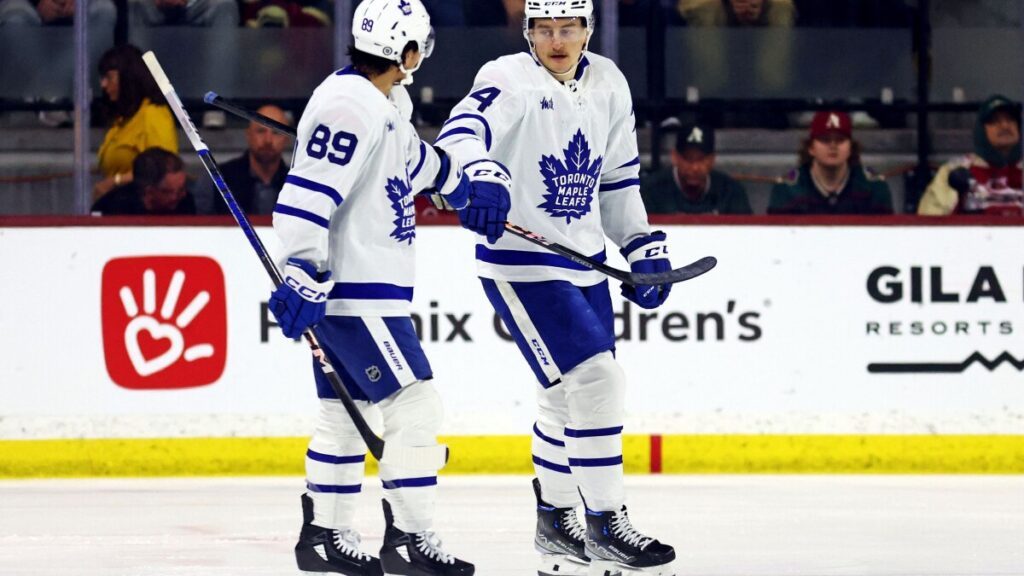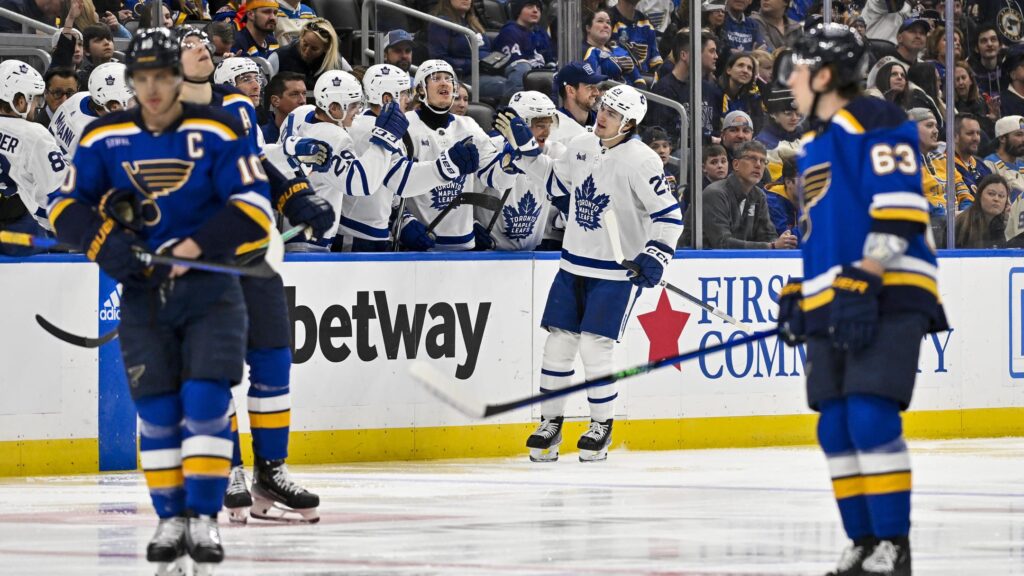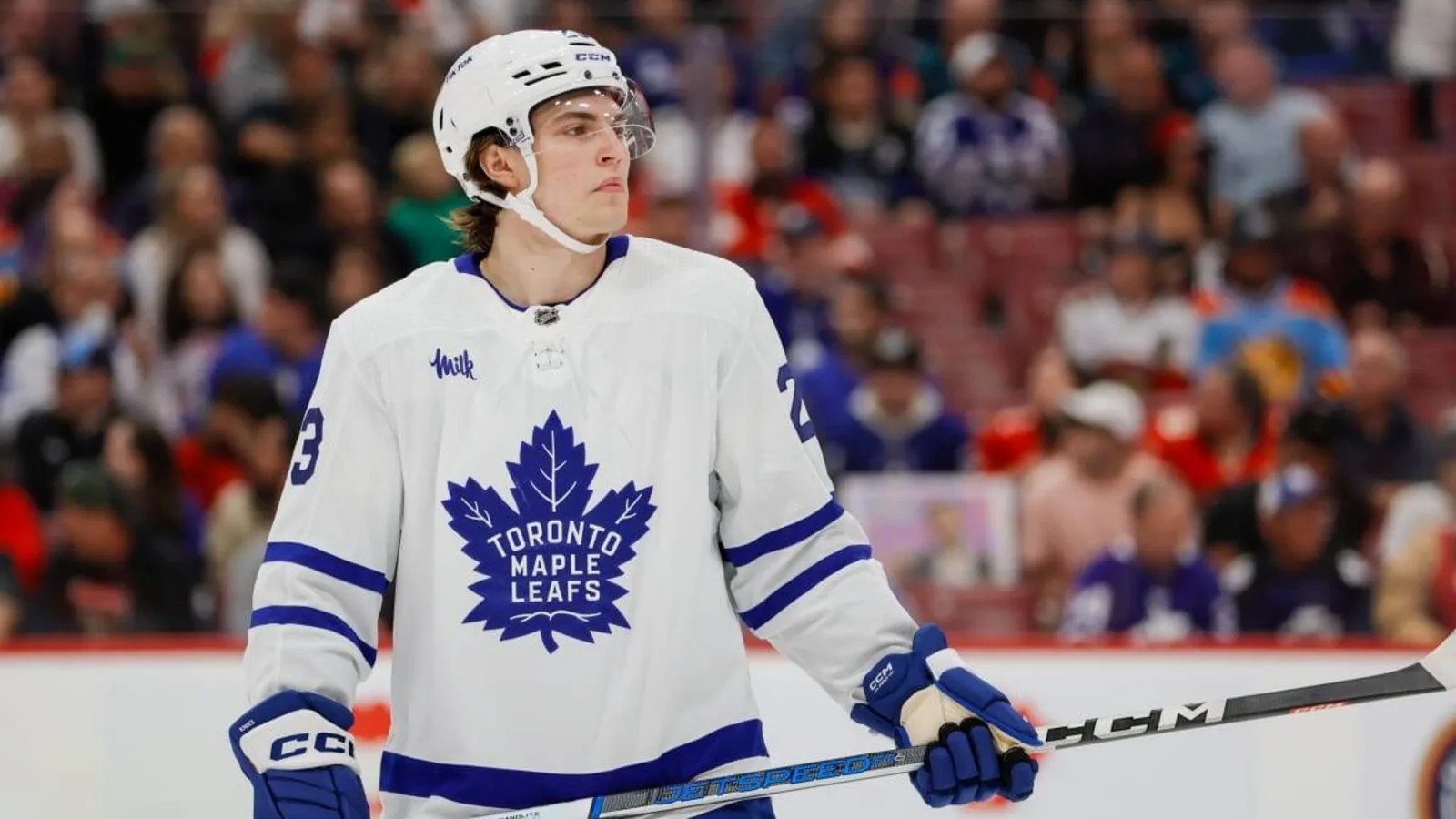Next up in the Offseason Evaluations series are Matthew Knies and Bobby McMann, two left wingers coming off their first full (full-ish in McMann’s case) seasons in the NHL. What steps could they take in 2024-25, and how might they fit into the Maple Leafs’ lineup?
Find my previous three pieces in the Offseason Evaluations series below:
- Offseason Evaluations, Part 1: Auston Matthews & William Nylander
- Offseason Evaluations, Part 2: Mitch Marner & John Tavares
- Offseason Evaluations, Part 3: David Kampf & Calle Jarnkrok
Bobby McMann

| Bobby McMann | |
|---|---|
| 2023-24 Production | 15 goals and 24 points in 56 games (11:33 per game) |
| 5v5 Results | 50.95 CF% | 50.06 xGF% | 29 goals for, 18 goals against |
| Contract Status | Two years remaining at $1.35 million AAV |
The story of Bobby McMann’s 2023-24 season starts the year before. In the 2022-23 season, he sustained a knee injury with the Toronto Marlies. During his second call-up stint with the Toronto Maple Leafs, he re-aggravated an injury, and as it turned out, he tore his adductor.
As a result, McMann was limited in training camp, didn’t get into any preseason games, and was placed on waivers at the end of camp. Thankfully for the Leafs, he went unclaimed and reported to the Marlies, where he played six games, put up three points, and was then called up because Ryan Reaves was already -11.
Funny enough, the Leafs also recalled Simon Benoit for the same game against Vancouver as John Klingberg struggled. It turned into a pretty important day for the organization as both players made their season debuts and later signed multi-year extensions. McMann joined the fourth line with Kampf and Gregor, and it was the best game of the season for the fourth line to this point (they scored twice).
It was a bit of a whirlwind for McMann afterward, though. The team flew across the ocean to play in Sweden for the next three games the following weekend. The club went 3-0, and when they flew back home, McMann was a healthy scratch.
A week and a half later, McMann got into the lineup against the Kraken, took a penalty, was on for two goals against, and played just 5:44 (I wouldn’t say either goal was directly his fault, but he went to the wrong spots in the neutral zone, leading to both entries). He then sat again for two weeks, came back into the lineup against the Rangers, and was again on the ice for two goals against. However, he remained in the lineup for the next game and scored his first career goal against the Penguins.
The first few months for McMann as a Leaf basically followed this pattern of playing low-end fourth-line minutes or not playing at all. In December, he averaged 9:39 in nine games; in January, he averaged 9:36 in 10 games. But he started playing regularly and featured in 19 of the team’s 21 games before he was placed on IR due to a lingering injury. At the time, there was speculation McMann might be placed on waivers as Calle Jarnkrok broke his knuckle and they needed to make roster room for Tyler Bertuzzi, who was returning after the birth of his child.
McMann’s IR stint synced up with the team’s bye week, so he returned when the team did in February, dressing in a game against the Islanders. He played in all three games out of the break, with ice times of 7:28, 8:12, and 7:22. He was slated to be a healthy scratch for the team’s next game, but a flu bug struck the locker room, so he was a last-second insert against the St. Louis Blues, against whom he scored a hat trick. Before his big game, McMann averaged 9:10 per game in 26 games, scoring twice and totaling seven points. After the hat trick? 30 games, 13 goals, and 17 points while playing 13:38 per night.
Not only did that game seem to spark McMann offensively, but it also pushed the coaching staff to play him more alongside better players. McMann was stuck on the fourth line before, but after his breakout, he moved up the lineup and played with John Tavares. In 225 minutes, they owned over 53 percent of the shot attempts, expected goals were 57.04 percent, and the actual goals were 14-5.
McMann, a pending UFA at the time, was rewarded with a two-year contract extension for his efforts. It’s a low-risk, high-reward bet for the Leafs, as McMann looked like a potential top-six forward for a good chunk of the season. He has all the tools on paper: He’s big, fast, strong, and he owns a great shot. His speed and ability to get in on the forecheck meshed well with the slower John Tavares.
When McMann played with other skilled players, such as Nylander and Marner, he was skilled enough to keep up with them in terms of making plays with the puck, fast enough to keep up with Nylander, and aggressive enough to retrieve pucks. He’s also strong defensively; when Marner was out, the line of McMann – Tavares – Nylander was routinely taking the tough matchups (making life much easier for the Bertuzzi – Matthews – Domi line), and they outscored opponents 6-2. McMann’s strength helps him win battles along the wall to get pucks out of his own zone. He even flashed potential as a penalty killer.
McMann is clearly a useful player, but the question marks are twofold.
Can he stay healthy? This season, he missed the playoffs due to an injury. It was a notable loss for the Leafs, as even a couple of goals from him would have drastically shifted the balance of a very tight series. Last season, McMann battled injuries as well. He played 65 pro games the season before, but he needs to show that he can push for 82.
The second question is: How good is McMann really? Obviously, he caught fire in February and March. In April, he did cool down before his injury, recording just a single goal—his only point—in seven games that month (if you called it six games—he was injured in the first period vs. Detroit—and pointed out the team didn’t play real hockey all month while Matthews chased 70, I could grant you that).
Even if McMann is simply a 20-goal, 40-ish-point power forward, it would be a huge addition for the Leafs. Bertuzzi scored 21 goals and 43 points last season, and while they’re different players, McMann offers speed and potentially penalty-killing ability. If he’s anything more than that, he’s a heck of a player. If he’s less, he can take a regular shift and chip in some offense.
To me, a perfect scenario would involve the Leafs keeping Bertuzzi or adding another quality left winger plus a center. This would mean a third line featuring either McMann or Knies—depending on how each progresses this offseason—next to Tavares, with an open competition for the other winger spot between players like Nick Robertson, Pontus Holmberg, and Easton Cowan.
Beyond his five-on-five play, McMann can chip in as a penalty killer and a second-unit power-play option who is effective in the bumper spot, which is where he played for the Marlies with success and where he started to click for the Leafs in the final few months.
Matthew Knies

| Matthew Knies | |
|---|---|
| 2023-24 Production | 15 goals and 35 points in 80 games (13:40 per game) |
| 5v5 Results | 49.59 CF% | 48.59 xGF% | 54 goals for, 42 goals against |
| Contract Status | One year remaining at $925,000 |
Matthew Knies entered the 2023-24 season with high expectations. It’s probably fair to call him the Leafs’ most touted prospect since the initial influx of promising young talent featuring Matthews, Marner, and Nylander.
Unlike those players’ situations, though, Knies was walking into a team expecting to win now, and his rookie season became a bit of a baptism by fire. Knies produced a great preseason and started the season on a line with Fraser Minten and Calle Jarnkrok. Pairing two rookies together is generally not a great idea unless they are elite talents, and the results weren’t encouraging. Minten was not ready to play in the NHL and lasted just four games before he was sent back to the WHL. In the game after Minten was sent down, Knies was placed on a line with David Kampf and Max Domi, and he scored twice in a comeback win against the Lightning.
That line was a bit like water and oil, mixing Knies and Domi’s skill with Kampf’s checking. At the same time, Tyler Bertuzzi was off to a slow start on the top line and was moved to the second line in favour of Calle Jarnkrok. By November 5, just 12 games into the season, Knies was forced up the lineup out of necessity rather than performance (before the promotion, he recorded four points in the first 11 games, three of which came in one game).
In Knies’ first game on the top line, also against Tampa Bay, he tallied three points again. In 12 games, he amassed seven points, six of which came against the Lightning. His production was very inconsistent, considering his shared ice with the NHL’s leading goal scorer and one of its better point-producing wingers.
In December, Knies notched just four points in 11 games. January was the low point, with three points in 12 games. Between December 27 and February 10, Knies battled a 17-game goalless drought. He was a complete afterthought on the power play, averaging just 38 seconds per game on the man advantage (ninth among regular Leafs forwards).
Scoring in February did help Knies’ confidence, though. He produced his best month of the season by far, piling up nine points in 12 games. In March, injuries scrambled the lines; Marner got injured, and Bertuzzi and Domi moved up the lineup. Knies received looks throughout the lineup – with Tavares and Nylander, with McMann on the third line, with Holmberg and Robertson, and even a game on the fourth line. If we look through Knies’ underlying numbers, they were below water with everyone except for Matthews, Marner, and… Bobby McMann. The flashes were there, but as with most rookies, the consistency was not.
When the playoffs rolled around, Knies wound up on a line with Tavares and Nylander for most of it due to injuries, and he got stronger as the series went along. In the series’ final two games, he played 19:10 and 18:43 – his two highest totals of the entire season. Knies asserted himself physically, scored a big goal in overtime, and created space and turnovers with his size and speed. He was a noticeable difference-maker as the series wore on.
Knies is a good young player who produced a very promising playoff showing for the second straight year. He somewhat reminds me of versions of Alex Lafreniere and Chris Kreider, who are power wingers with speed and excel at creating space for themselves in the tight checking of the playoffs. There is a lot to like here.
From the organization’s standpoint, the Leafs need to better chart a proper plan for this kid. Clearly, they wanted him to develop on a lower line to start the season, but Tyler Bertuzzi didn’t click on the top line as expected, so Knies was shoehorned up the lineup. He has posted some reasonable underlying numbers in those situations, but it’s really driven by Matthews and Marner. The best we can say about the Knies-Matthews-Marner line last season is that Knies didn’t make them worse, but he also didn’t make them better.
Knies also played no defined role on the power play (are they really going to develop a skilled young player by not giving him proper power-play time?). He was asked to penalty kill due to a lack of penalty killers (as Sheldon Keefe said during the season, they were trying to “manufacture” PK options). After an entire season, I couldn’t tell you where Knies was supposed to play on the power play or what his role could potentially be on the man advantage.
There were times last season when Knies moved down the lineup and was a beast against lesser players; moving to the third line with McMann stands out, as does his game against the Panthers alongside Holmberg and Robertson and his game in New Jersey late in the season when he joined the fourth line and dominated his shifts.
There were all sorts of positive flashes from Knies throughout the season, but going through his games and revisiting my in-game notes, I continually flagged that it would be a tough go for him playing against high-end competition night in and night out. It felt like the organization let him down more than anything with what they asked of him and the positions they placed him in. Some of it was simply a reality of the roster situation. When Bertuzzi-Matthews-Domi emerged and McMann came out of nowhere, Knies moved down the lineup and looked far more comfortable.
Perhaps Knies learns from the experience of getting thrown into the deep end and comes back better for it. That is entirely possible, and it wouldn’t be particularly surprising. At the same time, the Leafs must be prepared for the slower, non-linear development that many power forwards experience in the league.
A 15-goal, 35-point forward on the first line is not helping anyone. Similar to the situation with McMann, ideally, the Leafs will have a veteran left winger who can be trusted to play on the top line or move down the lineup should Knies/McMann take a step forward. Even more ideally, they need a proper center to pair with the winger who isn’t playing with Matthews/Tavares. It will make their life easier, especially from a defensive and puck-movement standpoint.
Next up in the Offseason Evaluations series: Pontus Holmberg & Ryan Reaves














![John Gruden after the Leafs prospects’ 4-1 win over Montreal: “[Vyacheslav Peksa] looked really comfortable in the net… We wouldn’t have won without him” John Gruden, head coach of the Toronto Marlies](https://mapleleafshotstove.com/wp-content/uploads/2025/09/gruden-post-game-sep-14-218x150.jpg)

















